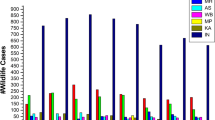Abstract
In Zimbabwe, veterinary fences are used to control trypanosomiasis and foot- and-mouth disease, two important diseases that threaten cattle production and beef exports. Wildlife is implicated in both instances and the effects of fences on wildlife conservation and land use are discussed in relation to these two diseases. Advantages and disadvantages related to direct and indirect fence effects are outlined. Although the maintenance of fences for trypanosomiasis control is likely to become obsolete, control of foot- and-mouth disease will rely on fences for the foreseeable future. Most of Zimbabwe's protected wildlife areas are located in marginal agricultural land around the periphery of the country where cattle productivity is low. This land should be excluded from any involvement in the beef export industry rather than attempting its inclusion through cordoning and isolating individual protected areas. Within such land, the need for rigid veterinary restrictions should then disappear and allow more flexible strategies for disease control, including adaptive and imaginative approaches to land-use planning.
Similar content being viewed by others
Literature cited
Anon. 1961. Annual Report, 1960. Department of Wild Life Conservation, Southern Rhodesia. Government Printer, Salisbury.
Bourn, D. 1978. Cattle, rainfall and tsetse in Africa.Journal of Arid Environments 1:49–61.
Buxton, P. A. 1955. The natural history of tsetse flies. London School of Tropical Medicine and Hygiene Memoir 10. H. K. Lewis, London.
Cockbill, G. F. 1967. The history and significance of trypanosomiasis problems in Rhodesia.Proceedings and Transactions of the Rhodesia Scientific Association 52:7–15.
Coetsee, A. M., and R. D. Taylor. 1978. Hand capture of buffalo calves for research purposes.South African Journal of Wildlife Research 8:173.
Condy, J. B. 1979a. A history of foot and mouth disease in Rhodesia.Rhodesia Veterinary Journal 10:2–10.
Condy, J. B. 1979b. Foot and mouth disease.Zimbabwe Rhodesia Science News 13:175–176.
Condy, J. B., and R. S. Hedger. 1974. The survival of foot and mouth disease virus in African buffalo, with non-transference of infection to domestic cattle.Research in Veterinary Science 16:182–185.
Condy, J. B., and R. S. Hedger. 1978. Experiences in the establishment of a herd of foot and mouth free African buffalo (Syncerus coffer).South African Journal of Wildlife Research 8:87–89.
Conway, A. J. 1984. Anti-poaching measures in Chirisa Safari Area, Zimbabwe. Pages 164–181in D. H. M. Cumming and P. Jackson (eds.), The status and conservation of Africa's elephants and rhinos. International Union for Conservation of Nature and Natural Resources, Gland.
Drury, M. R. 1982. Wildlife in marginal areas.Zimbabwe Wildlife 29:24–27.
Foggin, C. M. 1981. Disease problems associated with wildlife utilisation on Zimbabwe farms.Zimbabwe Science News 15:187–189.
Hedger, R. S. 1976. Foot and mouth disease in wildlife with particular reference to the African buffalo (Syncerus caffer). Pages 235–244in L. A. Page (ed.), Wildlife diseases. Plenum, New York.
Hursey, B. S., and R. Allsopp. 1983. Sequential application of low dosage aerosols from fixed-wing aircraft as a means of eradicating tsetse flies (Glossina spp.) from rugged terrain in Zimbabwe. Tsetse and Trypanosomiasis Control Branch, Department of Veterinary Services, Zimbabwe.
Jones, D. M. 1982. Conservation in relation to animal disease in Africa and Asia. Pages 271–285in M. A. Edwards and U. McDonnell (eds.), Animal disease in relation to animal conservation. Academic Press, London.
Jordan, A. M. 1979. Trypanosomiasis control and land use in Africa.Outlook on Agriculture 10:123–129.
Koeman, J. H., F. Balk, and W. Takken. 1980. The environmental impact of tsetse control operations.FAO Animal Production and Health Paper 7 (Review 1):1–71.
Laws, R. M., I. S. C. Parker, and R. C. B. Johnston. 1975. Elephants and their habitats: the ecology of elephants in North Bunyoro, Uganda. Clarendon, Oxford.
Martin, R. B. 1986. Communal area management programme for indigenous resources (Campfire). Revised version. Branch of Terrestrial Ecology, Department of National Parks and Wild Life Management. Government Printer, Harare.
Martin, R. B., and R. D. Taylor. 1983. Wildlife conservation in a regional land-use context: the Sebungwe region of Zimbabwe. Pages 249–270in R. N. Owen-Smith (ed.), Management of large mammals in African conservation areas. Haum, Pretoria.
Molyneux, D. H. 1982. Trypanosomes, trypanosomiasis and tsetse control: impact on wildlife and its conservation. Pages 29–55in M. A. Edwards and U. McDonnell (eds.), Animal disease in relation to animal conservation. Academic Press, London.
Omerod, W. E. 1978. The relationship between economic development and ecological degradation: how degradation has occurred in west Africa and how its progress might be halted.Journal of Arid Environments 1:357–379.
Onyiah, J. A. 1978. Fluctuations in numbers and eventual collapse of aGlossina palpalis (R-D) population in Anara Forest Reserve of Nigeria.Acta Tropica 35:253–261.
Percival, A. B. 1924. A game ranger's notebook. Nisbet, London.
Plowright, W. 1982. The effects of rinderpest and rinderpest control on wildlife in Africa. Pages 1–28in M. A. Edwards and U. McDonnell (eds.), Animal disease in relation to animal conservation. Academic Press, London.
Selous, F. C. 1893. Travel and adventure in south-east Africa. Rowland Ward, London.
Sinclair, A. R. E. 1979. Dynamics of the Serengeti ecosystem: process and pattern. Pages 1–30in A. R. E. Sinclair and M. Norton-Griffiths (eds.), Serengeti: dynamics of an ecosystem. University of Chicago Press, Chicago.
Taylor, R. D. 1982. Buffer zones: resolving the conflict between human and wildlife interests in the Sebungwe region.Zimbabwe Agricultural Journal 79:179–184.
Author information
Authors and Affiliations
Rights and permissions
About this article
Cite this article
Taylor, R.D., Martin, R.B. Effects of veterinary fences on Wildlife conservation in Zimbabwe. Environmental Management 11, 327–334 (1987). https://doi.org/10.1007/BF01867160
Issue Date:
DOI: https://doi.org/10.1007/BF01867160




